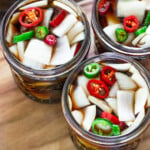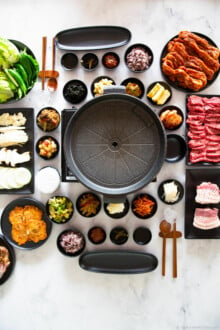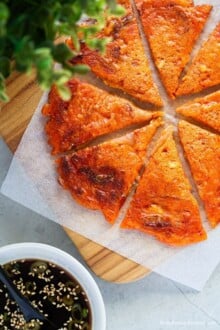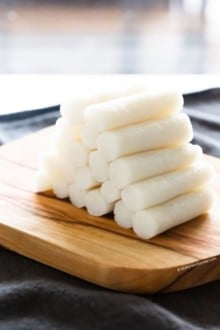Have you ever tried Korean pickled onions? They are so addictive that it’s hard to stop at one bite. They go well with any Korean dish. Whether it’s Korean BBQ, Korean pancakes, or just plain rice, these pickled onions are so good. They are very easy to make and will take you less than 15 minutes from start to finish. Give it a try!
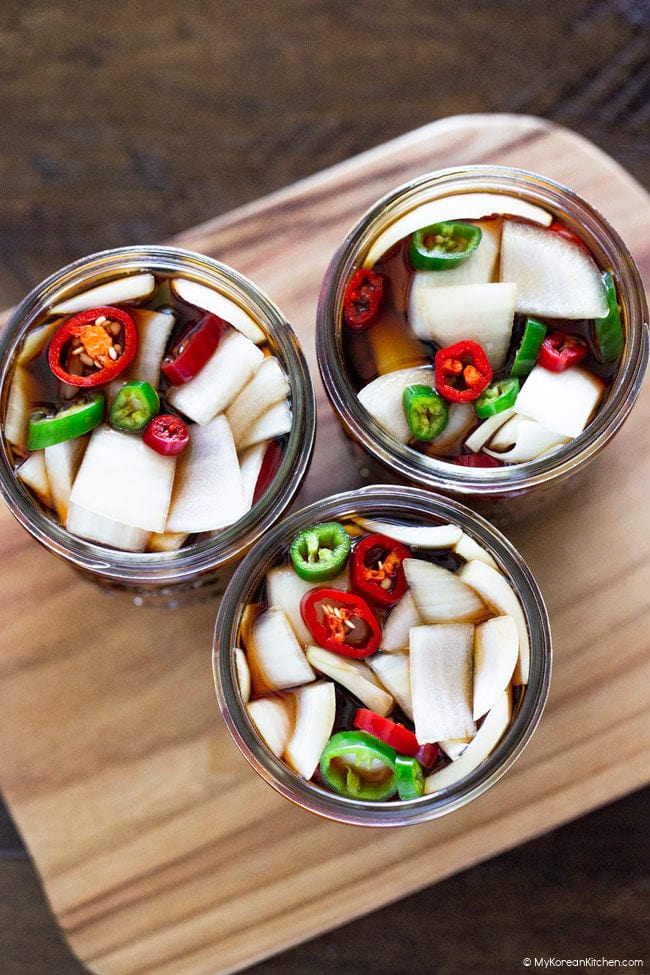
What are Pickled Onions
Korean Pickled Onions (Yangpa Jangajji, 양파 장아찌) is a traditional side dish in Korea. It keeps for months and is often served with Korean BBQ.
As for the recipe, it is so simple. Chopped onions are placed in a jar and covered with a brine solution containing soy sauce, vinegar, and sugar. It is left to sit at room temperature for 3 to 4 hours before being put in the fridge. The pickled onions can be eaten straight away once chilled, but it usually needs to sit in the fridge for a few days for it to fully develop flavor. The strong onion taste will also diminish as the days go by.
Korean Pickled Onion with Chilies
One way to make pickled onions even better is to add hot peppers. These will give the brine some spiciness, slightly altering the flavor of the pickled onions. The subtle kick that chili pepper gives can be a nice addition to your dish if you want to spice it up a little bit.
Along with adding flavor, chili peppers can be used to add seasonal vibrancy to the food. When pickled onions are served they will look more appetizing, thanks to the chili’s green and red colors.
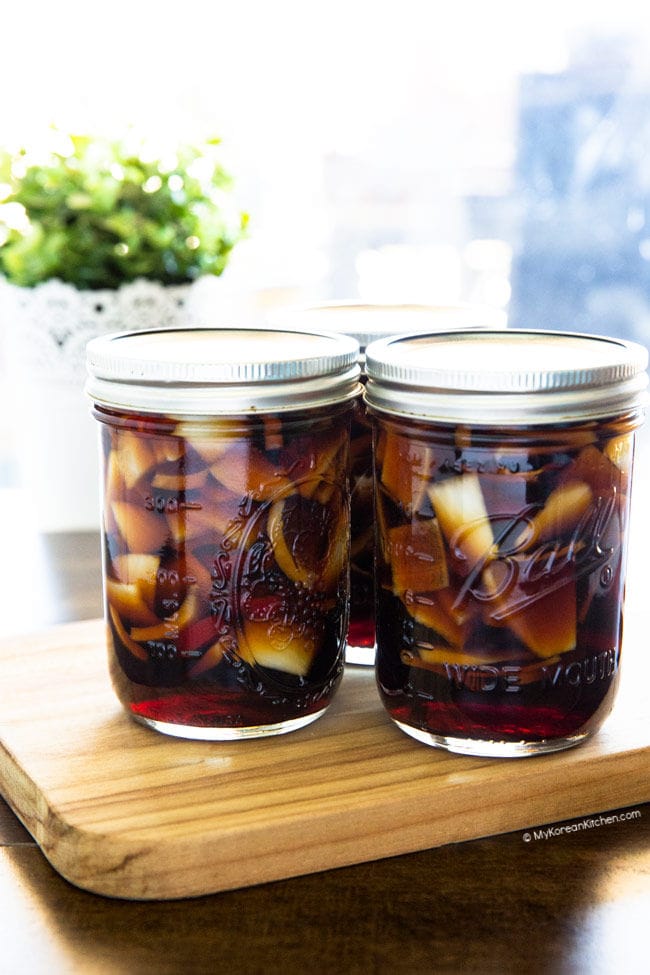
How Long Do Pickled Onions Last
If you store pickled onions in your refrigerator, you can expect them to last for at least a month. But it can vary depending on the saltiness of your brine. If it is weaker, then it may not last as long.
You also need to make sure that you don’t open the container too much, as this will increase the chances of the onions going bad. As a contrasting example, some of my un-opened pickled onions were still in excellent condition with fresh onion crispness intact even after one month. Once opened, the jar lasted for another month, though near the end, the onion was softer.
What To Eat with Pickled Onions
Pickled onions go well with anything. Whether it’s Korean BBQ, Korean Pancake, or just plain rice. You can even use them as a topping into tacos, sandwiches, and burgers. I just love how versatile this onion side dish is! So be sure to experiment with them and see what you else you can come up with!
Other Quick Pickle Recipes
If you love pickles, you should try these recipes. They are so easy to make and make a great side dish to any Korean meal!
- Pickled Carrots and Daikon Radish
- Cucumber Pickles with Lemon
- Pickled Chili Peppers
- Pickled Perilla Leaves
- Quick Pickled Radishes
Ingredients for Korean Pickled Onions
- 450 g / 15.9 ounces onion, chopped
- (optional) 45 g / 1.6 ounces chili, green and red, thinly sliced
- 1 cup water
- 1 cup soy sauce, regular (I use naturally brewed kikkoman soy sauce.)
- 1 cup apple vinegar or rice wine vinegar
- 1 cup raw sugar
* 1 Cup = 250 ml
** Above ingredients will require 3 x 330 ml preserving jars or 1 x 1 L jar. Be sure to sterilize the jar beforehand.
How to Make Pickled Onions
1. Separate the chopped onions and place them in a sterilized glass jar. (Add some sliced chilies between layers if you opted to include them.)
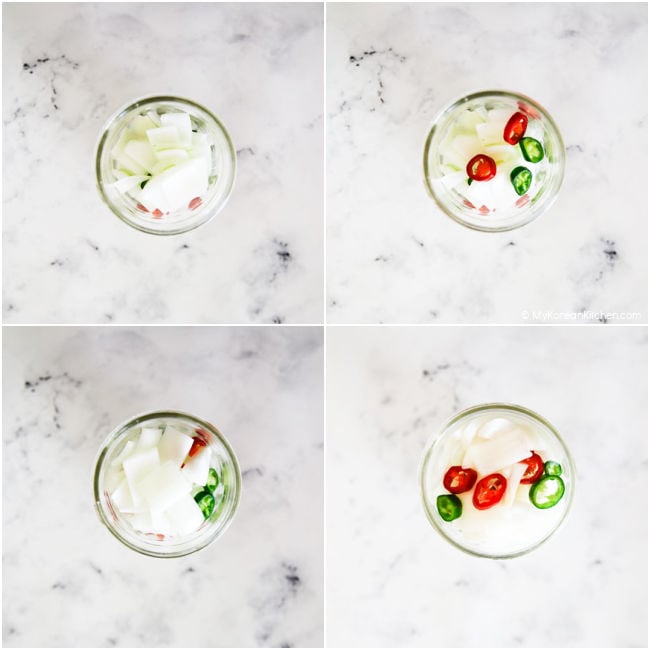
2. Combine the water, soy sauce, vinegar and sugar in a saucepan and boil over low to medium heat until the sugar dissolves (about 2-3 minutes). Stir often.
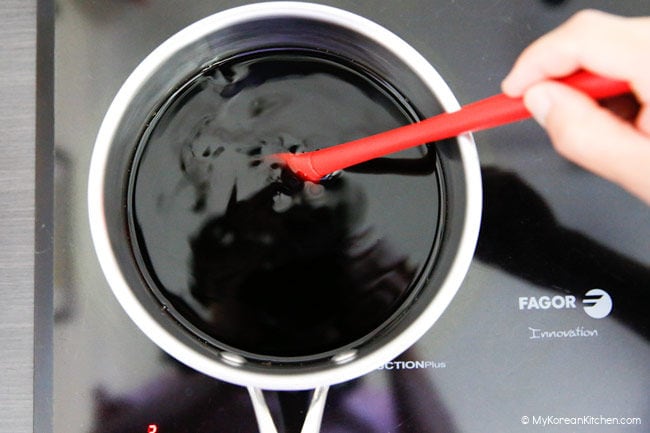
3. Pour the brine over the onion and close the lid. Leave at room temperature for 3 to 4 hours then refrigerate. It should be ready to eat in 1 to 2 days.
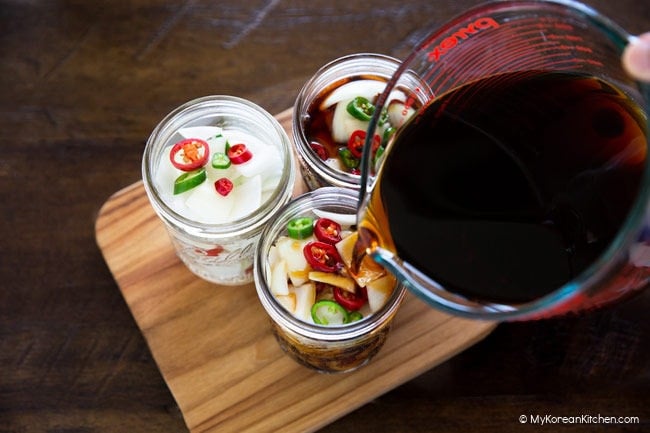
4. Serve with your favorite main meal (e.g. Bindaetteok or Korean BBQ). It can be refrigerated in an airtight container for at least one month.
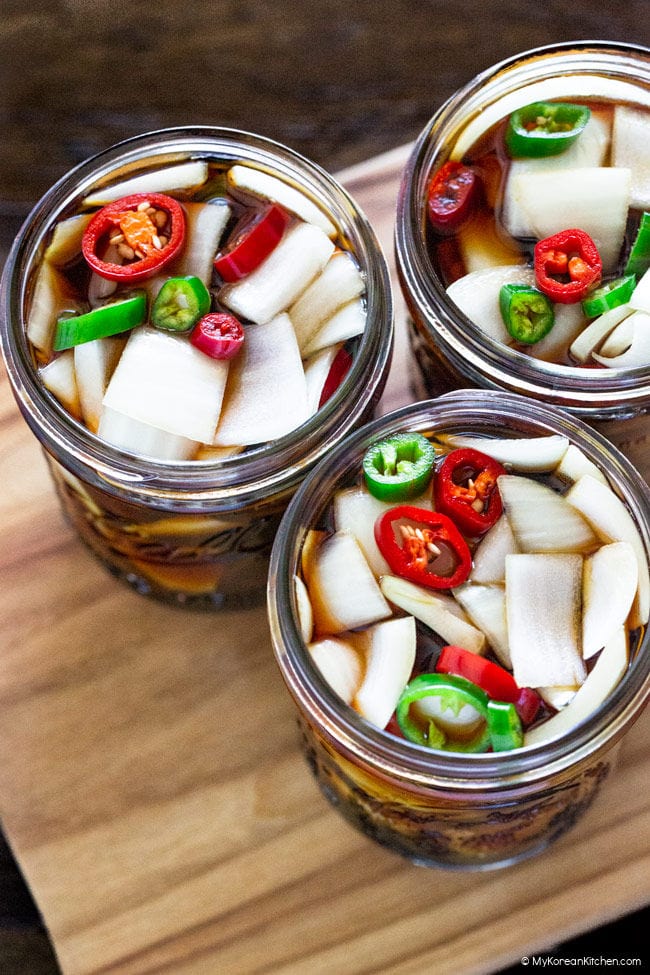
Love Korean food? Browse lots more Korean recipes from my easy Korean recipe collections. And subscribe to my newsletter and follow along on Facebook, Pinterest and Instagram for all of the latest updates.
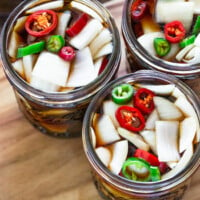
Pickled Onions (Yangpa Jangajji)
Ingredients
- 450 g onion (15.9 ounces), chopped
- 45 g chili (optional), green and red, thinly sliced
- 1 cup water
- 1 cup soy sauce , regular (I use naturally brewed kikkoman soy sauce.)
- 1 cup apple vinegar or rice wine vinegar
- 1 cup raw sugar
Instructions
- Separate the chopped onions and place them in a sterilized glass jar. (Add some sliced chilies between layers if you opted to include them.)
- Combine the water, soy sauce, vinegar and sugar in a saucepan and boil over low to medium heat until the sugar dissolves (about 2-3 minutes). Stir often.
- Pour the brine over the onion and close the lid. Leave at room temperature for 3 to 4 hours then refrigerate. It should be ready to eat in 1 to 2 days.
- Serve with your favorite main meal (e.g. Bindaetteok or Korean BBQ). It can be refrigerated in an airtight container for at least one month.
Notes
- 1 Cup = 250 ml
- Above ingredients will require 3 x 330 ml preserving jars or 1 x 1 L jar. Be sure to sterilize the jar beforehand.
Nutrition Info (per serving)
The nutrition information shown is an estimate provided by an online nutrition calculator. It should not be considered a substitute for a professional nutritionist’s advice.
